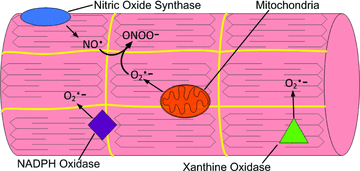Reactive oxygen species are signalling molecules for skeletal muscle adaptation
- PMID: 19880534
- PMCID: PMC2906150
- DOI: 10.1113/expphysiol.2009.050526
Reactive oxygen species are signalling molecules for skeletal muscle adaptation
Abstract
Increased reactive oxygen species (ROS) production is crucial to the remodelling that occurs in skeletal muscle in response to both exercise training and prolonged periods of disuse. This review discusses the redox-sensitive signalling pathways that are responsible for this ROS-induced skeletal muscle adaptation. We begin with a discussion of the sites of ROS production in skeletal muscle fibres. This is followed by an overview of the putative redox-sensitive signalling pathways that promote skeletal muscle adaptation. Specifically, this discussion highlights redox-sensitive kinases, phosphatases and the transcription factor nuclear factor-B. We also discuss the evidence that connects redox signalling to skeletal muscle adaptation in response to increased muscular activity (i.e. exercise training) and during prolonged periods of muscular inactivity (i.e. immobilization). In an effort to stimulate further research, we conclude with a discussion of unanswered questions about redox signalling in skeletal muscle.
Figures



References
-
- Allen RG, Tresini M. Oxidative stress and gene regulation. Free Radic Biol Med. 2000;28:463–499. - PubMed
-
- Anderson EJ, Neufer PD. Type II skeletal myofibers possess unique properties that potentiate mitochondrial H2O2 generation. Am J Physiol Cell Physiol. 2006;290:C844–C851. - PubMed
-
- Appell HJ, Duarte JA, Soares JM. Supplementation of vitamin E may attenuate skeletal muscle immobilization atrophy. Int J Sports Med. 1997;18:157–160. - PubMed
-
- Barja G. Mitochondrial oxygen radical generation and leak: sites of production in states 4 and 3, organ specificity, and relation to aging and longevity. J Bioenerg Biomembr. 1999;31:347–366. - PubMed
-
- Bassel-Duby R, Olson EN. Signaling pathways in skeletal muscle remodeling. Annu Rev Biochem. 2006;75:19–37. - PubMed
Publication types
MeSH terms
Substances
Grants and funding
LinkOut - more resources
Full Text Sources
Other Literature Sources

